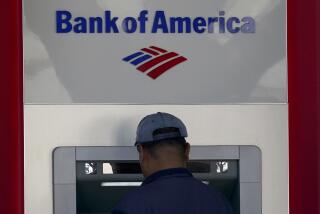Debate Over ‘Too Big to Fail’ Theory Renewed : Insurance: In some cases, even those with deposits exceeding the $100,000 limit on deposits are fully protected. : Is it fair?
- Share via
When Bank of New England was seized Sunday, the Federal Deposit Insurance Corp. extended full coverage to all accounts--including about $2 billion held in accounts above the $100,000 limit. The aim was to stem a run on deposits and bolster consumer confidence.
But the regulators’ seemingly well-intentioned motives served only to underscore a growing debate and fury in some segments of the banking industry that federal deposit insurance is selectively and unfairly awarded to account holders exceeding the insurance fund’s own rules.
Depositors in banks deemed “too large to fail” are exempted from the rules, unlike savers in smaller banks where the failure isn’t likely to undermine the nation’s banking confidence or cause a national uproar, critics charge.
What are the rules? When are they applied? Who breaks them? Here’s a quick rundown on FDIC insurance policies and their application:
Question: What are the FDIC insurance rules?
Answer: They are far too complicated and lengthly to repeat here in their entirety, but to be absolutely safe, remember the Rule of One: one bank, one person, one account under $100,000.
Of course there are variations. Individual retirement accounts and Keogh accounts are insured separately from checking and savings accounts. A full copy of the rules may be obtained from your bank or the FDIC Regional Office, 25 Ecker St., Suite 2300, San Francisco, Calif. 94105.
Individual savers, unsure of the rules or nervous about the safety of their institution, should heed the oft-repeated advice to spread their money around to several institutions rather than risk losing any of it.
Q: What kind of accounts typically exceed the limits?
A: According to Veribanc, a firm that rates banks’ financial strength, about $570 billion of the $2.8 trillion held in U.S. banks as of last June 30 was held in accounts exceeding $100,000. No precise breakdown of this amount exists, but analysts say it is divided among three large groups of depositors: corporations, governmental bodies and “large net worth” individuals.
Because of their need for quick and regular access to huge sums to meet payroll, dividend, pension and other payment requirements, governmental agencies and corporations typically maintain accounts that exceed the insurance limits.
Individuals who choose to exceed the limits, analysts say, do so for the convenience of keeping all their accounts at a single institution--and for the extra interest their jumbo deposits can earn. Typically, interest rates on a $100,000 account are from 0.25 to 0.5 percentage points higher than those paid on smaller accounts. And rates are often individually negotiated for single accounts in excess of $100,000.
Q: In what types of banks are these huge accounts held?
A: In most cases, analysts say, depositors put their huge accounts where they have a special relationship--or a reason to trust that their money is safe beyond the insurance limits.
In many cases, corporations bolster their own borrowing ability by maintaining large deposits. Local governments help support their financial and business communities by maintaining large deposits in local banks. And individuals may know their banker and be coddled by the red carpet service offered in return for their large deposits.
But by far the largest single reason depositors feel safe enough to flaunt the insurance limits, analysts say, is the government’s own “too big to fail” philosophy of protecting large deposits in the nation’s biggest banks.
No breakdown exists of where the $570 billion of theoretically “uninsured” funds are held. But analysts estimate that by far the vast majority is in the nation’s 30 to 50 largest banks, institutions most likely to be afforded full insurance in the event of failure.
Q: How does the FDIC apply its insurance rules? Do big banks really get a special deal?
A: The FDIC says it offers full coverage--even to deposits exceeding its insurance limits--in about 90% of bank failures. In these instances, the FDIC is able to arrange a “purchase and assumption” of the failed bank’s deposits and all or part of its loan portfolio by a healthy institution.
In the remaining cases, deposits are insured only up to the legal limits when the bank is liquidated, or only its deposits are transferred to another bank. Of the 168 banks that failed last year, 148 were purchased and assumed by a healthy institution.
Although the FDIC’s policies do not explicitly favor larger institutions, analysts and FDIC officials themselves acknowledge that because larger institutions are more likely to attract a buyer, their depositors are more likely to get greater FDIC insurance coverage.
Congress is expected to address deposit insurance reform this year in legislation that also will provide for financing the dwindling insurance fund. The fund is expected to lose about $5 billion this year from bank failures, after about $4 billion in losses last year.
As one measure, Bush Administration officials are considering limiting the number of accounts per depositor covered by federal deposit insurance. However, smaller banks have argued that limiting insurance coverage would unfairly hurt them, because depositors would flock to larger banks considered too big to fail.
American Bankers Assn. officials argue that the best way to protect the insurance fund is not to cut back the current level of insurance coverage but to stop covering uninsured deposits when a large bank fails.
“We’ve been saying right along that the ‘too big to fail’ policy puts too much stress on the bank insurance fund and needs to be eliminated,” said ABA spokesman Mark Burneko.
BIGGEST BAILOUTS Here is a list of the five costliest commercial bank rescues to date by the Federal Deposit Insurance Corp.:
Bank Location Date Amount 1.First RepublicBank Corp. Dallas July 29, 1988 $2.9 billion 2.MCorp Dallas March 29, 1989 $2.7 billion 3.Bank of New England Boston Jan. 6, 1991 $2.3 billion 4.Continental Illinois Chicago May 17, 1984 $1 billion 5.First City Bancorp. Houston April, 20, 1988 $979 million
The cost estimates were the latest available from FDIC documents and are subject to change depending on the ultimate recovery realized by selling the failed banks’ delinquent loans and repossessed real estate.
More to Read
Inside the business of entertainment
The Wide Shot brings you news, analysis and insights on everything from streaming wars to production — and what it all means for the future.
You may occasionally receive promotional content from the Los Angeles Times.










